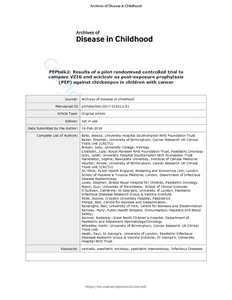Bate, J;
Baker, S;
Breuer, J;
Chisholm, JC;
Gray, J;
Hambleton, S;
Houlton, A;
Jit, M;
Lowis, S;
Makin, G;
et al.
Bate, J; Baker, S; Breuer, J; Chisholm, JC; Gray, J; Hambleton, S; Houlton, A; Jit, M; Lowis, S; Makin, G; O'Sullivan, C; Patel, SR; Phillips, R; Ransinghe, N; Ramsay, ME; Skinner, R; Wheatley, K; Heath, PT
(2019)
PEPtalk2: results of a pilot randomised controlled trial to compare VZIG and aciclovir as postexposure prophylaxis (PEP) against chickenpox in children with cancer.
Arch Dis Child, 104 (1).
pp. 25-29.
ISSN 1468-2044
https://doi.org/10.1136/archdischild-2017-314212
SGUL Authors: Heath, Paul Trafford
![[img]](https://openaccess.sgul.ac.uk/109856/1.hassmallThumbnailVersion/PEPtalk2%20results%20of%20a%20pilot%20randomised%20controlled%20trial%20to%20compare%20VZIG%20and%20aciclovir%20as%20postexposure%20prophylaxis%20%28PEP%29%20against%20chickenpox%20in%20children%20with%20cancer..pdf)  Preview |
|
PDF
Accepted Version
Available under License ["licenses_description_publisher" not defined].
Download (440kB)
| Preview
|
Abstract
OBJECTIVE: To determine the likely rate of patient randomisation and to facilitate sample size calculation for a full-scale phase III trial of varicella zoster immunoglobulin (VZIG) and aciclovir as postexposure prophylaxis against chickenpox in children with cancer. DESIGN: Multicentre pilot randomised controlled trial of VZIG and oral aciclovir. SETTING: England, UK. PATIENTS: Children under 16 years of age with a diagnosis of cancer: currently or within 6 months of receiving cancer treatment and with negative varicella zoster virus (VZV) serostatus at diagnosis or within the last 3 months. INTERVENTIONS: Study participants who have a significant VZV exposure were randomised to receive PEP in the form of VZIG or aciclovir after the exposure. MAIN OUTCOME MEASURES: Number of patients registered and randomised within 12 months of the trial opening to recruitment and incidence of breakthrough varicella. RESULTS: The study opened in six sites over a 13-month period. 482 patients were screened for eligibility, 32 patients were registered and 3 patients were randomised following VZV exposure. All three were randomised to receive aciclovir and there were no cases of breakthrough varicella. CONCLUSIONS: Given the limited recruitment to the PEPtalk2 pilot, it is unlikely that the necessary sample size would be achievable using this strategy in a full-scale trial. The study identified factors that could be used to modify the design of a definitive trial but other options for defining the best means to protect such children against VZV should be explored. TRIAL REGISTRATION NUMBER: ISRCTN48257441, EudraCT number: 2013-001332-22, sponsor: University of Birmingham.
| Item Type: |
Article
|
| Additional Information: |
This article has been accepted for publication in Archives of Disease in Childhood following peer review. The definitive copyedited, typeset version Bate J, Baker S, Breuer J, et al PEPtalk2: results of a pilot randomised controlled trial to compare VZIG and aciclovir as postexposure prophylaxis (PEP) against chickenpox in children with cancer Archives of Disease in Childhood 2019;104:25-29 is available online at: http://dx.doi.org/10.1136/archdischild-2017-314212 |
| Keywords: |
paediatric haematology, paediatric oncology, prophylaxis, varicella, paediatric haematology, paediatric oncology, prophylaxis, varicella, Pediatrics, 1103 Clinical Sciences, 1114 Paediatrics And Reproductive Medicine, 1117 Public Health And Health Services |
| SGUL Research Institute / Research Centre: |
Academic Structure > Infection and Immunity Research Institute (INII) |
| Journal or Publication Title: |
Arch Dis Child |
| ISSN: |
1468-2044 |
| Language: |
eng |
| Dates: |
| Date | Event |
|---|
| January 2019 | Published | | 5 May 2018 | Published Online | | 17 April 2018 | Accepted |
|
| Publisher License: |
Publisher's own licence |
| Projects: |
|
| PubMed ID: |
29730641 |
 |
Go to PubMed abstract |
| URI: |
https://openaccess.sgul.ac.uk/id/eprint/109856 |
| Publisher's version: |
https://doi.org/10.1136/archdischild-2017-314212 |
Statistics
Item downloaded times since 29 May 2018.
Actions (login required)
 |
Edit Item |



